Tower of the Winds
The Tower of the Winds or the Horologion of Andronikos Kyrrhestes is an octagonal Pentelic marble clocktower in the Roman Agora in Athens that functioned as a horologion or "timepiece". It is considered the world's first meteorological station. Unofficially, the monument is also called Aerides (Greek: Αέρηδες), which means Winds. The structure features a combination of sundials, a water clock, and a wind vane.[1] It was supposedly built by Andronicus of Cyrrhus around 50 BC, but according to other sources, might have been constructed in the 2nd century BC before the rest of the forum. In summer of 2014, the Athens Ephorate of Antiquities began cleaning and conserving the structure; restoration work was completed in August 2016.[2]
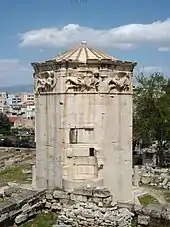
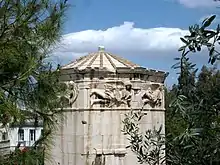
Site
The 12-metre-tall structure has a diameter of about 8 metres and was topped in antiquity by a weathervane-like Triton that indicated the wind direction.[3] Below the frieze depicting the eight wind deities—Boreas (N), Kaikias (NE), Apeliotes (E), Eurus (SE), Notus (S), Lips (SW), Zephyrus (W), and Skiron (NW)—there are eight sundials.[3] In its interior, there was a water clock (or clepsydra), driven by water coming down from the Acropolis. Research has shown that the considerable height of the tower was motivated by the intention to place the sundials and the wind-vane at a visible height on the Agora, effectively making it an early example of a clocktower.[4] According to the testimony of Vitruvius and Varro, Andronicus of Cyrrhus designed the structure.[5] The tower's columns bore capitals of a design now known as "Tower of the Winds Corinthian", although they lack the volutes ordinarily found in Corinthian capitals.

In early Christian times, the building was used as the bell-tower of an Eastern Orthodox church. Under Ottoman rule it became a tekke and was used by whirling dervishes. At that time it was buried up to half its height, and traces of this can be observed in the interior, where Turkish inscriptions may be found on the walls. It was fully excavated in the 19th century by the Archaeological Society of Athens.
 View of the tower
View of the tower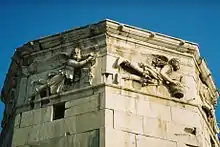 The Tower of the Winds, with the frieze showing the wind gods Boreas (north wind, on the left) and Skiron (northwesterly wind, on the right)
The Tower of the Winds, with the frieze showing the wind gods Boreas (north wind, on the left) and Skiron (northwesterly wind, on the right) Inside: Roof of tower
Inside: Roof of tower Inside: Floor of tower showing holes for mechanism
Inside: Floor of tower showing holes for mechanism General view of the tower, from Stuart & Revett's The Antiquities of Athens, 1762
General view of the tower, from Stuart & Revett's The Antiquities of Athens, 1762 Layout of the interior of the tower, from Stuart & Revett's The Antiquities of Athens
Layout of the interior of the tower, from Stuart & Revett's The Antiquities of Athens 18th-century reconstruction of the Tower of the Winds from The Antiquities of Athens
18th-century reconstruction of the Tower of the Winds from The Antiquities of Athens
Buildings inspired by the Tower of the Winds
Several buildings are based on the design of the Towers of the Winds, including:
- The 18th-century Tower of the Winds on top of the Radcliffe Observatory in Oxford, England,
- The St Pancras Church (1822) designed by William Inwood and his son Henry William Inwood, located in Euston, London. This is a unique Greek-revival church, that features two sets of Caryatids and a tower that was based on the classical Tower of the Winds.
- The Daniel S. Schanck Observatory (1865) an early astronomical observatory at Rutgers University in New Brunswick, New Jersey.[6]
- The mausoleum of the founder of the Greek National Library Panayis Vagliano at West Norwood Cemetery, London.
- The 15th-century Torre del Marzocco in Livorno.
- The tower on St Luke's Church, West Norwood, in London, designed by Francis Octavius Bedford after he visited Athens on a Society of Dilettanti scholarship circa 1810.
- A similar tower in Sevastopol, built in 1849.
- The Temple of the Winds, which stands in the grounds of Mount Stewart near Newtownards in Northern Ireland.[7]
- The Carnaby Temple near Carnaby, East Riding of Yorkshire, built in 1770.
- The Maitland Robinson building in Downing College Cambridge, designed by Quinlan Terry in 1992.
- The "Storm Tower" in Bude, Cornwall (1835), by George Wightwick
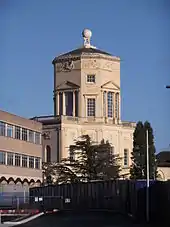 John Bacon and James Wyatt's 1794 scaled-up version of the Tower of the Winds, in Oxford, England
John Bacon and James Wyatt's 1794 scaled-up version of the Tower of the Winds, in Oxford, England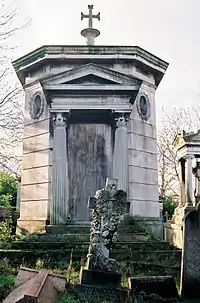 Vagliano tomb at West Norwood Cemetery, London, inspired by the Tower
Vagliano tomb at West Norwood Cemetery, London, inspired by the Tower The Tower of the Winds in Sevastopol
The Tower of the Winds in Sevastopol
References
- Joseph V. Noble; Derek J. de Solla Price, p. 345
- "Ancient Greece's restored tower of winds keeps its secrets, KAROLINA TAGARIS & PHOEBE FRONISTA | Kathimerini". www.ekathimerini.com.
- Joseph V. Noble; Derek J. de Solla Price, p. 353
- Joseph V. Noble; Derek J. de Solla Price, p. 349
- Joseph V. Noble; Derek J. de Solla Price, p. 354
- Rutgers, The State University of New Jersey – Rutgers University Libraries – University Archives. "Daniel S. Schanck Observatory" at Paths to Historic Rutgers: A Self-Guided Tour. Retrieved 3 October 2013.
- "Mount Stewart". UK: National Trust. Retrieved 22 April 2016.
Further reading
- Joseph V. Noble; Derek J. de Solla Price: The Water Clock in the Tower of the Winds, American Journal of Archaeology, Vol. 72, No. 4 (1968), pp. 345–355.
- James Beresford: A Monument to the Winds, Navigation News, Mar/Apr 2015, pp. 17–19.
- Pamela A. Webb, The Tower of the Winds in Athens. Greeks, Romans, Christians, and Muslims: Two Millennia of Continual Use, (Philadelphia 2017)
External links
![]() Media related to Tower of the Winds at Wikimedia Commons
Media related to Tower of the Winds at Wikimedia Commons